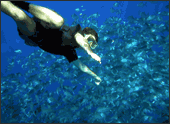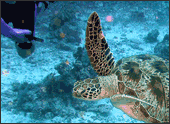
Tuesday, September 19, 2006
Sipadan Island

Sipadan Island
Lying just off the Northeast coast of Borneo is Sipadan, Malaysia's only oceanic island. Shaped by volcanic activity aeons ago, this 35-acre island rises about 700 metres from the sea floor, attracting diverse marine life from the blackness of the open sea.The spectacular diving, unrivalled anywhere else in the country, has made Malaysia a world class diving destination. Encounters with turtles, resident schools of jacks and barracudas are almost assured around the tiny coral island.
Since January 2005, Sipidan was declared a Marine Park and there is no longer accommodation available on the Island. Nearby Mabul hosts a range of options, including a unique offshore converted oil platform that is used as a dive base. There are several other possibilities that will allow you to still experience the special ambience of diving in the region of the atoll. Recent reports have indicated that the move to sanctuary status - while unpopular at the time - may well help to preserve the uniqueness of visits here.
Sipadan Island, also a declared bird sanctuary, is home to monitor lizards, fruit bats, the unique coconut crabs, and a luxuriant rainforest. About 47 known species of birds frolic and feed about on the natural vegetation, providing yet another attraction for the visitor.
Sipadan Island: Barracuda Point
Sipadan Island: Barracuda Point
The dive usually begins with the reef on your right, as you descend to the reef top at about 6 to 8 metres you will be greeted by schools of fusiliers; bump head wrasses congregate at the reef top. Growth of coral life extends to depths between 30 to 40 metres with huge barrel sponges, black coral trees, sea whips and soft corals. Huge black marble stingrays, schools of surgeonfish, large tunas, manta rays and clouds of pyramid butterfly fish greet the divers along the wall. Currents that sweep the valley section of the site attracts school of batfish, white tip sharks resting at the sandy bottom, barracudas, jacks, turtles, hammerhead sharks, gray reef sharks (carcharhinus anblyrhynchos) and even the leopard shark (stegostoma fafciatum) at the valley pass.
As you ascend from the 18 metre-depth of the valley to the gentle slopes at the side you can observe garden eels, triggerfish and even exceptional macro marine animals like the leaf-fish, frogfish, blennies, mantis shrimps and numerous nudibranchs.
Sipadan Island: Hanging Gardens
 Sipadan Island: Hanging Gardens
Sipadan Island: Hanging Gardens
As the name suggests, this pretty dive site has a profusion of colourful soft corals; some shaped like cauliflower plants and even grape-like shapes growing from under hangs along the wall.
The reef top is about 6 metres and plunges steeply to the depths. Here, you will encounter colourful crowds of reef fish such as butterfly fish, angelfish, squirrelfish, boxfish and lots of nudibranches. Friendly sweetlips and groupers will curiously check out divers - great for underwater photography. Small ledges encountered usually have small shrimps wedged between bubble coral, fire tail gobis darting about their burrows and the occasional lobster peering out between crevices. As the site is located on the western part of the island, dives should be in the afternoon, with better sunlight penetration. The soft corals come alive and extend their body size by almost three times when currents sweep the reef all providing a breathtaking view.
currents sweep the reef all providing a breathtaking view.
Sipadan Island: South Point
The furthest dive site from the island jetty is a 10 minutes' ride in a dive boat. South Point is similar to Barracuda Point, as currents sweep across the reef. Depending on the drift, it is best to start your dive with the reef on your left. The reef topography follows a gentle slope from about 7 to 55 metres at the sandy bottom shelf.
Here, chances are usually good to sight big fish: manta rays, leopard sharks, Napoleon wrasses, groupers and a kaleidoscope of smaller reef fish abound. Assuming you are diving with the wall on your left, you will come across sea fans and sea whip corals at 25 metres' depth.
You might also encounter a school of jacks, prior to a dark, cloud of mass approaching - this is the largest school of barracudas to be seen anywhere. The school usually swims against the current, and if approached cautiously, will permit divers to swim alongside. Further along the sloping wall at about 25 metres is a ledge with coral rubble, where white tip sharks and leopard sharks rest on the bottom. If you dive this spot often and at the right time, you may chance upon observing the mating ritual of white tip sharks.
Sipadan Island: Turtle Cavern
Sipadan Island: Turtle Cavern
 Much has been written about the turtle cavern, referring to it as a turtle graveyard. In reality the turtles enter the cavern accidentally to rest but get lost in the labyrinth, then become disoriented and drown.
Much has been written about the turtle cavern, referring to it as a turtle graveyard. In reality the turtles enter the cavern accidentally to rest but get lost in the labyrinth, then become disoriented and drown.
The cavern is situated at the northern end of the island. Divers are often warned during their first orientation dive that they are not allowed to enter the cavern for their own safety. A signboard is also erected at the entrance of the Turtle Cavern providing further warning, so a curious diver won't end his stay in the cavern. However, visits into the cavern can be arranged with a qualified dive master leading 3 divers at a time. A cave diving certification is offered for the adventurous who wish to explore the labyrinths.
The dive begins along the wall of the drop-off and descends to about 20 metres. Depth in the cavern is about 21 metres, and you find the various connecting caverns rise to less than 4 metres from the surface. You will notice skeletal remains of perished turtles scattered randomly on the silty cavern floor. There are even the remains of what was once an egg-carrying female turtle. No coral growth is observed in the cavern. The only life forms are schools of silver sweepers, soldier fish and the flashlight fish.
Getting to Sabah
GETTING TO SABAH
Air
Malaysia Airlines operates regular flights from Kuala Lumpur, Johor Bahru and Kuching to Kota Kinabalu. Other major airlines also have flights from Singapore, Brunei, Jakarta, Manila, Hong Kong and Taipei.
Road
There is an excellent road system linking the principal cities. Express buses link major towns while mini-buses are used for shorter distances and within town areas. Taxis, mini-buses, ordinary buses and boats are the means of getting around. For journeys to towns further away, MAS operates daily flights to Labuan, Sandakan, Lahat Datu and Tawau.
Rail
There is a rail line from Beaufort and Tenom in the south but rail transport is otherwise little developed.
Rivers
In the interior regions, rivers form the 'roads', linking riverine communities and villages. Travel along these 'watery highways' is by sampans (small boats) or longboats.






